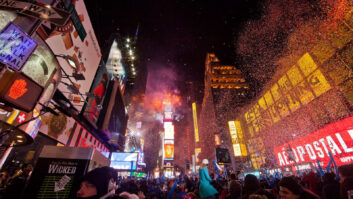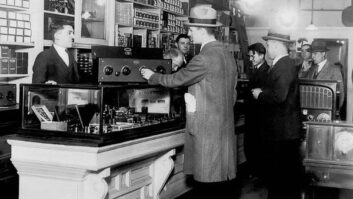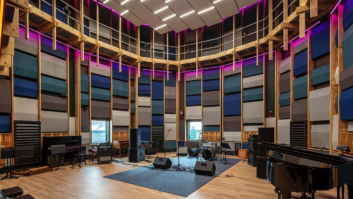From cost-conscious table-toppers to multi-thousand-dollar mainframes, effects manufacturers have added at least 25 new units in the 18 months since Winter NAMM 1998. Loads of software plug-in, multidynamic, live sound and guitar-oriented processors with control room applications were also released, but for space considerations, just studio-based digital multi-effects processors with at least five algorithms each are included in this ’98/’99 effects family tree.
The Alesis family has roots way back to the first Midiverb, circa 1985, and the Q20 ($999) now replaces the Q2 as their best-of-breed unit. Representing 14 years of multi-effects evolution, the Q20’s ADAT, XLR, 11/44-inch and optical and coaxial S/PDIF back-panel I/Os are internally complemented by a laundry list of 300 programs to control auto-pan, reverb, delay, Doppler fx, distortion and numerous other algorithms. Maximum reverb and delay times are 32 and five seconds, respectively, and up to eight effects can be used simultaneously. The Q20 routes signals in true stereo, series and parallel modes, and includes stereo sampling.
From Applied Research & Technology comes the DMV-Pro ($499). Each of the DMV’s dual discrete stereo channels has its own large data knob and edit display window, and can manage three simultaneous effects. A whopping 72 algorithms include reverbs, choruses, flanges, tremolos, delays and pitch programs, each of which has up to 12 parameters available, and a dynamic signal controller adjusts to levels present at the Pro’s 11/44-inch unbalanced inputs.
The Quadra/Fx ($249) operates as two true-stereo multi-effects processors that use ART’s proprietary Dynamic Allocation engine. Reverb tails can last up to 20 seconds, and delay times of up to five seconds are possible; there are two simultaneous MIDI controllers per program, and the Quadra boasts 24-bit internal and 20-bit A/D-D/A converters. Rounding out ART’s ’98/’99 units is the tabletop FX-1 ($134), which includes dual pitch-shifting among eight other effects types.
Behringer International’s new kids for ’99 include the Virtualizer Pro DSP1000P ($249) and Modulizer Pro DSP1200P ($249). Virtualizer is a dual-processor with 32 reverb algorithms and 512 effect variations that include delays, EQs, vocoding and rotary speakers, with internal 24-bit processing and 20-bit A/D-D/A audio streams through balanced XLR and 11/44-inch I/Os. Modulizer’s best subject is modulation effects, such as chorusing, phaser and 3-D processing, but it also has filtering, compression and bass enhancement. Also able to convert audio at 24-bit internal and 20-bit A/D-D/A, Modulizer and Virtualizer carry a suggested retail price of $250 each.
No two companies were more prolific on the multi-effects front over the last year-and-a-half than DigiTech and DOD. DigiTech’s Studio S-200 ($339) sports a huge custom display and true-stereo dual processors and includes 15 effects algorithms that can be patched in any order. Its smaller brother (S-100, $219) does everything the S-200 can sans the large display, but they both aspire to be as big as the Studio Quad4 ($479) when they grow up. Four discrete effects processors are configurable as either four independent mono or two true-stereo processors in the Quad4, and nifty effects like vocoder, reverse delay and spring reverb are standard equipment. With each unit having the same cool blue face, it’s not hard to see that these three come from the same family.
Also new since Winter NAMM ’98 are DOD’s Dimension 3 ($169) and VoTec ($199). The Dimension 3 includes reverbs, choruses, flanges and delays, each adjustable with two parameter data knobs; and as its name implies, the VoTec’s delay, EQ, compression, distortion and telephone simulator effects are great for processing vocals.
Picture a wunderkind genius that can belt a baseball out of Yankee Stadium, and you get an idea of Eventide’s latest addition, Orville. For $5,695 you could adopt ten medium-priced multi-effectors, but it’s unlikely they’d out-muscle the Orville Harmonizer’s pure power stroke. A massive range of multi-effects and dynamics processors are included, and 87 seconds of stereo sampling (174 seconds mono) can outdistance many a RAM-gorged rackmount sampler. Twenty-four-bit/96kHz capabilities, formant-correct vocal processing and 8×8 digital/analog simultaneous “anything-to-anything” I/O routing round out Orville’s report card.
If mere 87-second mono samples (43.5 stereo) that can be fed back into onboard effects will do, the DSP4500 Ultra-Harmonizer ($4,995) is another notable newbie from Eventide. It sports 24-bit converters inside and out and has all the software and features of the company’s venerable 4000 Series multi-effects processors, plus the custom Alchemy 101 Preset Library.
Korg is well-known for its line of guitar multi-effects that include the belt-strapable Pandora, but the AM8000 Ambience Multi Effect processor ($600) sports its own healthy audio tool belt that any studio can use. Eleven delay and reverb types are among 40 algorithms that include chorus, phase shift, modulation, tape delay, ring modulator and Doppler effects. There’s also 3-band EQ, compression and limiting; everything is processed with 18-bit resolution and AD 128x-oversampled at 48 kHz, and even Mr. Magoo could read the unit’s pleasantly oversized blue LED display.
Continuing the tradition of the legendary PCM 80 and PCM 90, Lexicon now offers the PCM 81 ($2,995) and PCM 91. Though not multi-effect by nature, the 91’s reverb-specific algorithms rate mention for working hand-in-hand with the 81’s new and improved selection of reverb, flange, chorus, delay, pitch shift and EQ programs. In addition to improved algorithms, the PCM 81 offers all the features of the PCM 80, as well as AES/EBU digital I/O.
The 480L Digital Effects System ($9,899) still remains the leader of the Lexi pack with new Version 4.0 software that includes room sizes as small as two square meters. More than 450 classic Lexicon halls, choruses and multiband delays abound, and the 480’s multimachine architecture is wide open for even more brain-power expansion. The Model 300 Digital Effects System ($4,995) offers an affordable subset of the 480’s algorithms and features timecode controls capable of translating formats internally, such as turning AES input to S/PDIF output. Full dynamic MIDI implementation is possible with any SysEx-savvy sequencer or automation program, and the Model 300L ($3,995) is a blank front-panel version of the 300 that’s controlled by the optional LARC remote control.
The MPX 100 ($299) uses an updated version of the Lexichip and offers coaxial digital S/PDIF output. This dual-channel true-stereo processor has nine algorithms including reverbs, pitch shifts and rotary speaker, and enough mental capacity to calculate six-second delays. Twenty-four-bit internal and 20-bit A/D-D/A converters, 240 presets, 16 user programs and tap-tempo control round out this new unit.
Long on family tradition is Peavey, whose Deltafex ($139), Deltafex Twin ($279) and Addverb III ($349) were all added to the roster since last year. The Deltafex is a cost-wise multi-effector that dropped another $20 in price recently, and its Deltafex Twin brother is twice as strong, packing two completely functional Deltafexes into a single 1U chassis. The Twin and the Addverb each have 16 effects types, including reverb and delay tails that finish even when changing programs, and there are two assignable parameter controls per algorithm. In addition, the Addverb III now features dual data wheels and true- stereo operation and fully comprehends and speaks MIDI.
Though not your typical multi-effects box, the RTSP-1600 ($789) from Pefftronics does include five effects that include flanging, chorus and delay programs. But the 1600’s best talent is randomly generating wild time-shift, doubling and modulation effects. This SIMM RAM-upgradeable unit uses triangle and sine waves to emulate manual flanging and other staples, and even if its Gaussian pseudo-random noise sequencer had to write “I will generate random effects” on the school chalkboard for 76 years, it wouldn’t once repeat the same effect.
Carrying on Sony’s multi-effects tradition is the DPS-V77’s follow-up, the DPS-V55 ($550). With the same DSP brains as the 77, the 55 offers up an impressive list of effects and bonus features that include an effects search tool and tap-tempo input control. Forty-five effects include reverbs, delays, modulation, pitch-shifts, filters, vocal cancel, vocoder, compression, 3-D sound and 4-channel surround algorithms, and the two-space rackmount unit boasts 20-bit A/D-D/A converters and 52-bit internal audio processing. The DPS-V55’s 11/44-inch analog connectors can be configured as 4×4 mono or two simultaneous true- stereo I/Os; there’s 200 custom producer-designed programs and 200 user slots available, and owners can download a free PC-based editor/librarian software program from Sony’s Web site.
TC Electronic has also brought new multi-effects units to market over the past 18 months, including the M5000 Digital Audio Mainframe ($4,100 to $8,550, depending on configuration). The M5000 has plenty of room to grow into its expansive open-system brain and boasts an endless array of sophisticated reverb, pitch-shift, multiband dynamic, delay, EQ, flanger and sampling algorithms. The unit speaks SMPTE and offers 20-bit A/D-D/A; an optional ATAC remote controller can control multiple M5000s.
TC’s M3000 Studio Effects Processor ($2,499) can reverberate, delay, pitch-shift, phase, compress, limit, expand and dynamically EQ the most savage signal with its dual-engine processors and proprietary Virtual Space Simulator technology. If your multi-effects kids can calculate AES/EBU, S/PDIF, TOS Optical, ADAT, MIDI and 24-bit true- stereo signals over simultaneous digital outputs, maybe they belong in the same Mensa class as the M3000.







